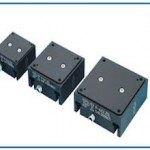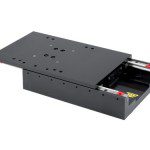There are several types of piezo motor that provide linear motion, with one of the most widely used being the linear stepper piezo motor. These devices harness the coordinated motion of multiple piezo elements to produce virtually unlimited travel with high resolution and very high stiffness. Construction and operation In the linear stepper design, multiple […]
physikinstrumente
FAQ: What are flexure guided piezo actuators?
When a voltage is applied to a piezoelectric material, it generates motion and force due to the expansion or contraction of the material. Piezo actuators take advantage of this effect, incorporating piezoelectric materials into useful devices for generating very small, high-frequency movements and producing relatively high forces. Flexure guided piezo actuators incorporate mechanical hinges (flexure […]
FAQ: Where are ultrasonic piezo motors suitable?
Ultrasonic piezo motors harness oscillations induced in a piezoelectric material to produce motion, which can be either rotary or linear. Their design and operation are relatively simple but allows them to achieve very high accelerations and speeds, and to produce high holding forces when no current is applied. Construction and operation For rotary motion, the piezo […]
PI’s newest compact rotary stage is 32 mm wide x 7 mm high
PI (Physik Instrumente) recently added a new piezo inertia drive rotary stage to its existing Q-Motion product line of compact linear and rotary systems – the Q-632. This compact micropositioning drive is only 32 mm wide, 7 mm high, and has a 30 mm turntable diameter with 360° rotation range. The Q-632 delivers precision rotation […]
FAQ: What benefits do piezo motors offer?
Piezo motors rely on piezo materials, which are ceramics that change shape when an electrical field is applied, to produce vibrations that cause motion—either linear or rotary. (Conversely, piezo materials can also produce electricity when mechanically loaded.) There are several principles on which piezo motors can operate, with the most common of these being the use of ultrasonic […]
Miniature Piezo Flexure Positioning Stage from PI
PI’s (Physik Instrumente) new PIHera Z flexure-guided piezo nanopositioning stage features travel ranges of 50 µm to 250 µm (400 µm open-loop). Flexure guided piezo positioning stages provide vibrationless motion with virtually unlimited resolution and fast response. Due to the lack of rolling elements, there is no bearing rumble to affect the uniformity or straightness […]
Linear motor stage with absolute encoder and ironless motor
Physik Instrumente has released a new member of the PIMag family of precision positioning stages with magnetic direct drives. The compact ultra-precise V-551 motorized linear translation stage debuted at Laser World of Photonics, held in Munich, Germany last month. V-551 comes equipped with an integrated absolute-measuring, 2nm resolution encoder – no more wasted time for […]
FAQ: What are piezo elements and piezo motors?
Piezo elements are ceramics that change shape when subject to electricity or (when subject to mechanical loading) output electricity. Manufacturers process and press plumbum, zirconate, titanate (PZT) powder together and fire it into a quartz. Then they integrate the ceramic with ferroelectric material to make electrodes. Finally, manufacturers apply electromagnetic fields to the piezo elements […]
Tighter integration and programming take positioning stages into 21st century
Few motion technologies show more recent innovation than positioning stages. Their hardware and software are increasingly custom to fit specific output requirements, thanks in large part to tighter integration and advanced programming. No wonder that today’s positioning stages can make moves with incredible accuracy; synchronize complicated axis commands; and optimize travel from coarse and fine […]
Piezoelectric Positioners offer Precise Control in Nanopositioning Applications
By Stefan Vorndran and Scott Jordan, PI, Physik Instrumente L.P. Ever-increasing requirements for more precise motion control has forced manufacturers of piezoelectric positioners to find ways to overcome their limitations, such as travel range and linearity, while preserving the unmatched speed, reliability and resolution capabilities of piezoelectric devices. Precision motion control in general, and nanopositioning […]











